Ever wondered how to make a tiny dining space feel cozy, stylish, and totally functional? Small dining rooms are more popular than ever, thanks to urban living, compact apartments, and clever design trends that prioritize maximizing every inch. These spaces can be challenging, but with the right ideas, they transform into charming dining retreats without feeling cramped or cluttered.
The key is smart planning and creative solutions that blend form and function seamlessly. In this article, you’ll find a treasure trove of inspiration and practical tips to elevate your small dining area.
From space-saving furniture and clever storage solutions to brightening techniques and stylish decor, we cover a wide variety of ideas to help you maximize space while showcasing your personal style. Whether you’re looking for quick updates or full redesigns, these ideas will empower you to create a beautiful, functional dining space—even in the smallest of rooms!
1. Utilize Multi-Functional Furniture for Compact Comfort

In small dining rooms, space efficiency isn’t just a bonus—it’s essential. Multi-functional furniture helps you make the most of every square inch while adding style and convenience to your daily routine.
Picture a sleek drop-leaf table with a warm oak finish that folds down when not in use, saving precious space. Pair it with benches that double as storage, upholstered in soft, neutral fabric, with hidden compartments underneath.
Imagine a fold-out side table that can be tucked away or brought out for extra dining space, and stackable chairs that can be nested neatly when not in use. The overall look is a clean, uncluttered environment with versatile pieces that adapt to your needs, creating a cozy yet functional dining nook.
The blend of smooth surfaces, natural wood tones, and soft textiles invites a welcoming, relaxed atmosphere. To implement this concept, start by choosing space-saving furniture pieces like a foldable table available at furniture stores or online.
Opt for benches with built-in storage—these are easy to find and assemble. For added flexibility, look for stackable or nesting chairs that can be stored away when not needed.
Focus on neutral colors and simple shapes to keep the space feeling open. If budget is a concern, repurpose existing furniture with DIY modifications, such as adding storage compartments or attaching foldable extensions. The key is selecting versatile pieces that can serve multiple functions effortlessly.
2. Incorporate Wall-Mounted Drop-Leaf Tables to Save Floor Space
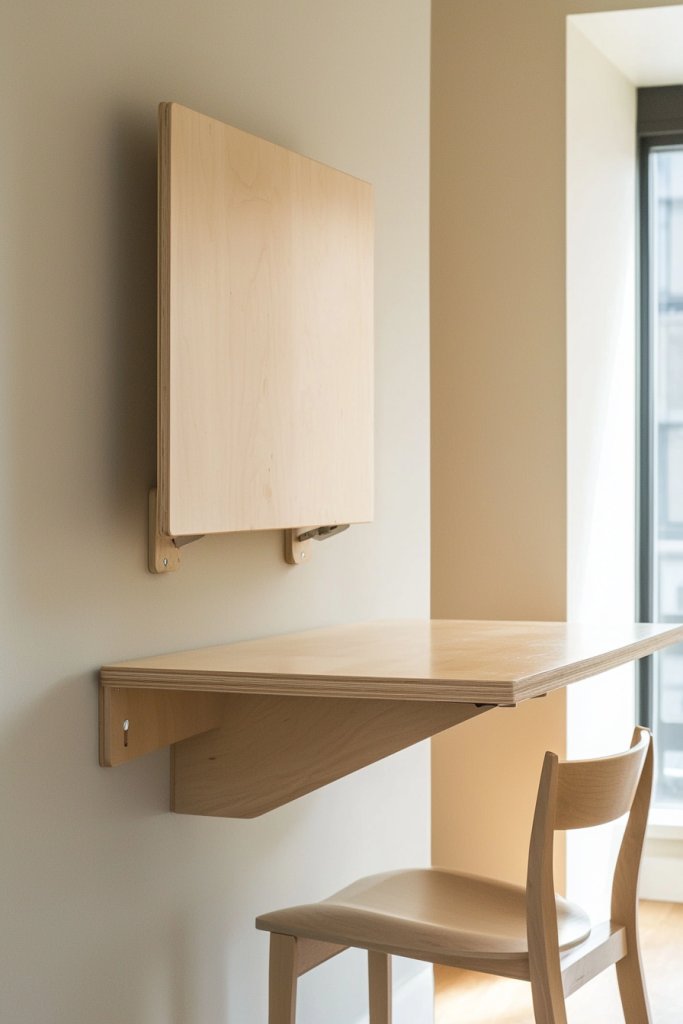
Wall-mounted drop-leaf tables are a game-changer for tiny dining areas, allowing you to have a functional table that doesn’t crowd your space when not in use. This clever solution creates a seamless, minimal look while maximizing your available square footage.
Imagine a slim, white wall-mounted table with two hinged leaves that fold down when you need more space and lift up to host guests. The surface is smooth, with a matte finish that reflects light gently, making the room appear larger.
When open, the table is perfect for intimate dinners, with enough room for two or four chairs. The surrounding walls are decorated with simple shelves or artwork, enhancing the airy feel.
The entire setup feels light and uncluttered, with the table blending into the wall when folded away, almost like a piece of modern art. To create this setup, start by selecting a wall-mounted table kit—these are available at most home improvement stores and online.
Install the mounting brackets securely into wall studs for stability. Choose a compact table made from wood, MDF, or laminate in a neutral color to match your decor.
When assembling, follow the manufacturer’s instructions carefully, and ensure the hinges operate smoothly. Add folding chairs or stools that can be tucked beneath the table or hung on hooks when not in use. This simple, stylish solution transforms your small dining area into a versatile space.
3. Opt for Slim Profile Chairs with Transparent or Clear Materials

Slim-profile chairs crafted from transparent or clear materials are a smart choice for small dining rooms, as they visually recede into the background, making the space feel open and airy. These chairs combine modern elegance with practicality, ensuring your room isn’t overwhelmed by bulky furniture.
Visualize a set of acrylic Ghost chairs or clear polycarbonate chairs with sleek, slender legs and a curved, comfortable seat. Their minimalist design means they don’t block sightlines or clutter the visual flow of the room.
In combination with a light-colored table—perhaps in white or pale wood—these chairs create a cohesive, almost invisible seating arrangement. The transparent elements allow light to pass through, adding to the sense of spaciousness.
The smooth, cool texture of the acrylic or polycarbonate feels sleek and modern, perfect for contemporary small dining spaces. To incorporate these chairs, look for budget-friendly options online or at furniture outlets, focusing on models with reinforced frames for durability.
Pair them with a lightweight, space-efficient table, such as a slim rectangular or round piece. If you prefer a softer look, choose chairs with subtle curves and cushioned seats in transparent or semi-transparent materials.
For added comfort, consider adding seat cushions in coordinating colors. These chairs are easy to move and store, making them an ideal choice for dynamic, small-scale dining areas.
4. Use Light Colors and Reflective Surfaces to Enhance Brightness

Light colors and reflective surfaces are the secret weapons to making small dining rooms feel larger and more inviting. They bounce light around the space, reducing shadows and creating an open, airy atmosphere that encourages socializing and relaxation.
Imagine walls painted in soft shades of cream, blush, or pale gray, paired with a glossy white or marble-look tabletop that reflects natural light. The room is filled with a gentle glow, enhanced by mirrored accents or chrome fixtures that amplify brightness.
Layer in textures like a light, woven rug and delicate curtains in sheer fabrics that let in daylight. The overall effect is a space that feels bright, clean, and expansive, even if it’s just a few square meters.
The reflective surfaces not only visually enlarge the room but also add a touch of sophistication. To achieve this look, start by choosing light-colored paint or wallpaper with subtle textures.
Incorporate mirrored wall panels or a large mirror to reflect light and expand the space visually. Opt for glossy or polished furniture surfaces, such as a high-shine table or metallic chairs, which catch and reflect light.
Complement these with light, neutral textiles—think a soft cream tablecloth or sheer drapes. Using natural light as your primary source, combine these elements for a bright, welcoming dining nook that feels much larger than it is.
5. Add Floating Shelves for Stylish Storage and Decor Display
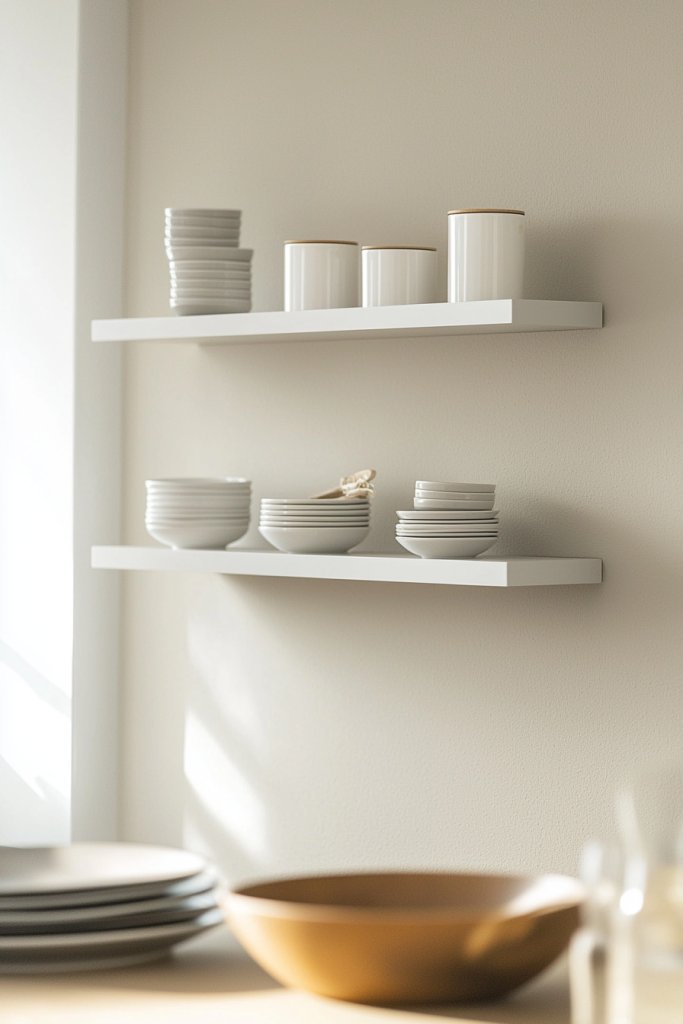
In small dining rooms, every inch of wall space counts. Floating shelves are a stylish and practical way to add storage, display decor, and keep clutter off the table—all without taking up valuable floor space.
Picture a set of white or natural wood floating shelves mounted above the dining area, holding ceramic vases, decorative bowls, or a few carefully curated books. The shelves are sleek and minimalist, with hidden brackets that give the illusion of floating effortlessly.
The display items are chosen in complementary colors—perhaps soft pastels or earthy tones—that add visual interest without overwhelming the space. The shelves create a layered, curated look that adds personality and functionality, making your dining area feel thoughtfully designed and uncluttered.
To implement this idea, select floating shelf kits suitable for your wall type, ensuring they can support the weight of your decor. Mount the shelves at varying heights to add visual depth, and organize items neatly, mixing textures like ceramics, glass, and woven baskets.
Keep the color palette light and neutral to avoid visual weight. Use the shelves to store small dishes, condiment jars, or decorative objects, keeping your tabletop clear for meals. This simple addition transforms your small dining space into a stylish, organized retreat with a personalized touch.
6. Implement Built-In Banquette Seating to Maximize Seating in Tight Spaces
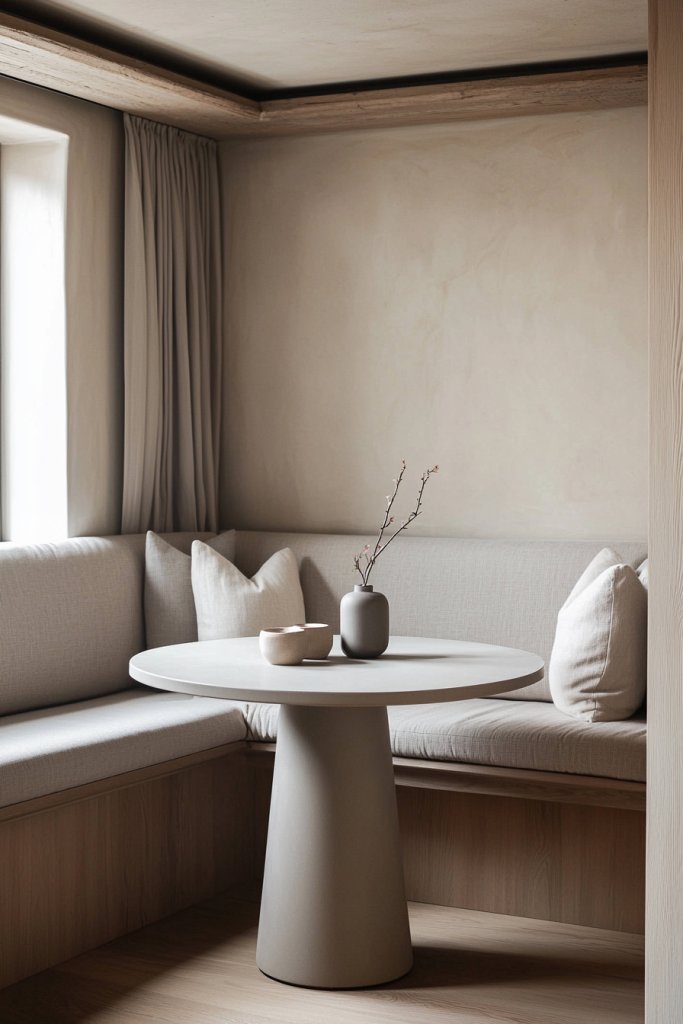
Imagine transforming a small dining nook into a cozy, stylish retreat that comfortably fits everyone—without sacrificing precious space. Built-in banquette seating is the perfect solution for maximizing seating in compact rooms, creating a seamless, custom look that feels both inviting and space-efficient.
This clever design not only adds charm but also cleverly utilizes every inch of your small dining area. Visualize a long, upholstered bench built into the wall, topped with plush cushions in soft fabrics like linen or velvet—think warm neutrals or muted pastels.
The seat might feature a sleek wooden base with hidden storage drawers underneath for tableware or linens. The backrest could be adorned with a textured throw or decorative pillows, adding visual interest and comfort.
Imagine warm light bouncing off a nearby mirror, making the space feel larger and more open, while the cozy, intimate vibe invites friends to linger longer. To recreate this look, start by assessing the available wall space and planning the dimensions of your bench.
Use sturdy wooden panels or prefabricated built-in kits, then upholster the seat with foam padding and fabric of your choice. Incorporate hidden storage beneath the seating by installing drawers or lift-up tops—this helps keep clutter out of sight.
Finish with decorative cushions in your preferred color scheme to tie the space together effortlessly. With a few tools and some basic carpentry skills, you can craft a custom banquette that transforms your small dining room into a stylish, functional haven.
7. Choose Round or Oval Tables to Create a Sense of Openness
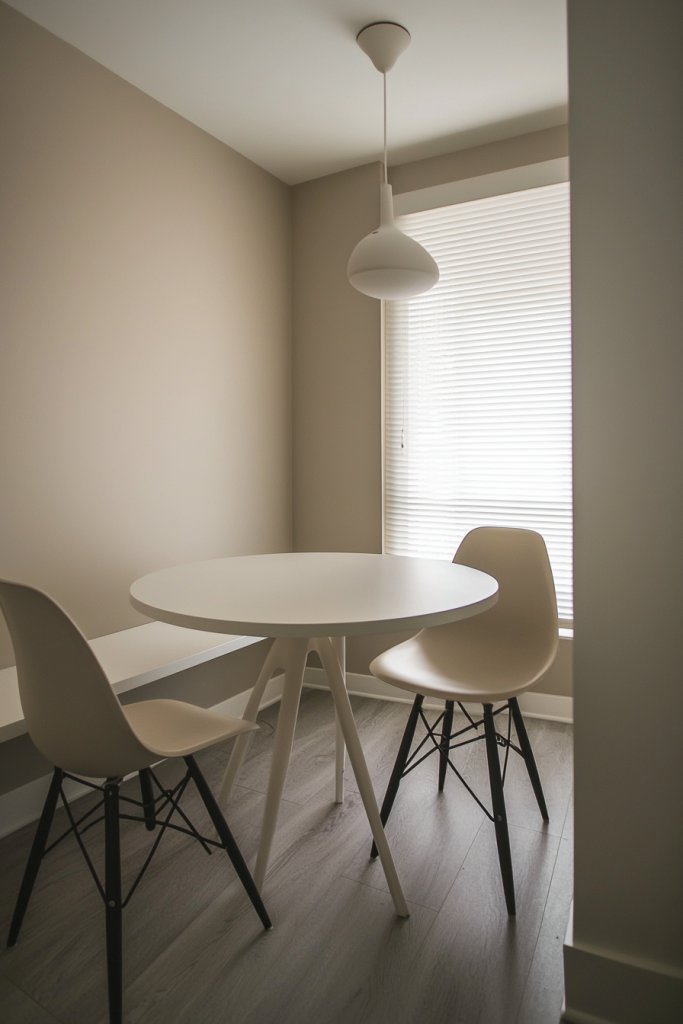
In a small dining room, the shape of your table can make all the difference in how spacious the area feels. Round or oval tables are excellent choices—they naturally soften the room’s edges and promote a sense of flow, making the space appear larger and less crowded.
Plus, they encourage more intimate conversations and create a welcoming atmosphere. Picture a sleek, wooden round table in a soft honey tone, with a smooth, polished surface that reflects light beautifully.
The table is paired with transparent acrylic chairs or slim-profile metal chairs, which further enhance the airy feeling. The absence of sharp corners allows for easier movement around the room, and the central shape visually expands the space, especially when paired with light-colored walls and minimal decor.
The table’s surface might be decorated with a simple ceramic vase holding fresh flowers or a few decorative candles—adding charm without clutter. To implement this idea, measure your available space carefully to choose a size that fits comfortably while leaving enough room to move around.
Opt for a round or oval table with a slender pedestal base to maximize legroom. If you prefer a DIY approach, consider repurposing a round table top from a thrift store and adding a lightweight, sturdy base.
Pair it with transparent or slim chairs, and keep the surrounding decor minimal to maintain an open, inviting feel. This approach instantly creates a more spacious, cohesive dining area that feels both functional and stylish.
8. Incorporate Mirrored Wall Panels to Create an Illusion of Space

Mirrored wall panels are a game-changer in small dining rooms, effortlessly doubling the visual space and flooding the room with light. By reflecting the room’s elements, mirrors trick the eye into perceiving a larger, more open area—bringing a sense of airiness and brightness that transforms the entire space.
Envision sleek, frameless mirror panels covering one wall, with their glossy surfaces catching and bouncing natural sunlight from your windows. The reflective quality amplifies the room’s depth, making even a modest dining area appear expansive.
You might add a decorative touch by framing the mirrors with slim, minimalist trims in brass or black matte, which add a modern edge. Complement this with light-colored walls, a neutral-colored table, and soft textiles to enhance the sense of openness.
When you walk into the room, the mirrors create a captivating visual extension, making the space feel larger and more inviting. To incorporate mirrors, start by choosing high-quality mirrored panels or large wall-mounted mirrors that suit your style.
Secure them firmly using appropriate wall anchors and hardware, ensuring safety and durability. For a seamless look, opt for frameless designs or sleek metallic frames that blend into your decor.
Position the mirrors strategically opposite windows or in areas that reflect the main seating zone to maximize their effect. Pair with simple, unobtrusive furniture and light decor, and you’ll have a small dining room that feels unexpectedly spacious and bright—an illusion that invites lingering and lively gatherings.
9. Use Vertical Space with Tall Cabinets or Storage Units
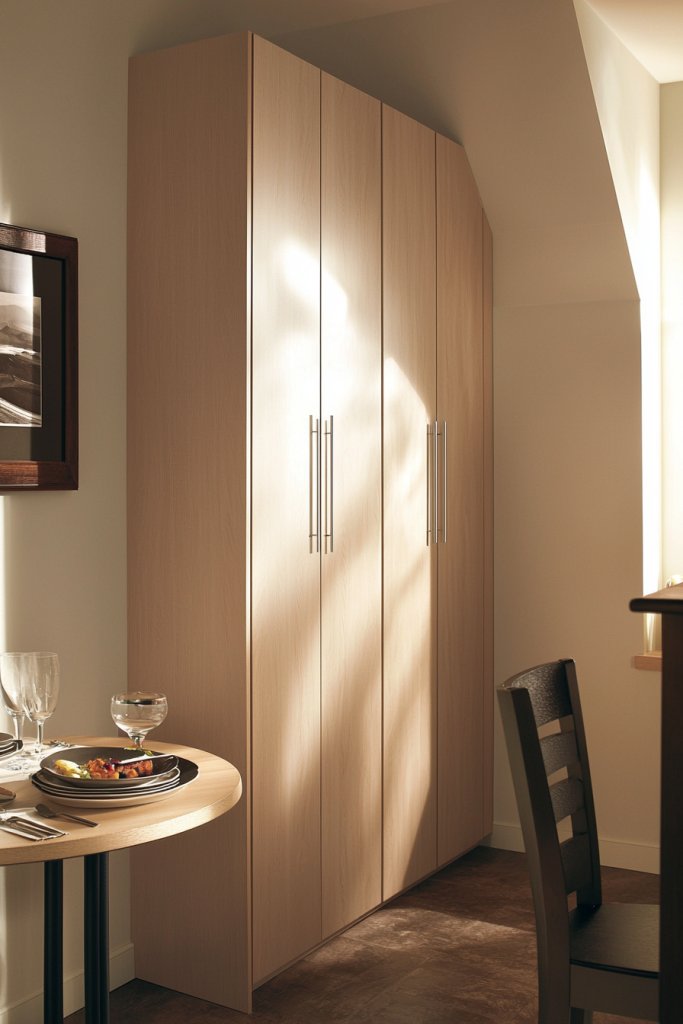
In tiny dining rooms, vertical space is often overlooked, yet it holds enormous potential for smart storage solutions. Tall cabinets or storage units capitalize on the room’s height, providing ample space for dishes, glassware, or even decorative items, all without encroaching on your limited floor area.
This approach keeps everything neatly organized and within reach, making your small dining space more functional and clutter-free. Imagine sleek, floor-to-ceiling white lacquer cabinets with minimalist handles, blending seamlessly into the wall.
The upper sections store seldom-used items or seasonal dinnerware, while the lower cabinets hold everyday essentials. The vertical design draws the eye upward, emphasizing height and creating a sense of grandeur in a confined space.
You might add open shelves on the sides for decorative bowls or vases, breaking up the cabinetry and adding personality. The overall effect is a clean, streamlined look that maximizes storage without sacrificing style.
To implement this, measure your available wall height and choose tall storage units or custom-built cabinetry accordingly. If building from scratch isn’t feasible, consider modular shelving systems or repurposed armoires painted in a light hue.
Install shelves or cabinets with simple, sturdy hardware, and organize items with baskets or decorative boxes for easy access. Incorporate lighting inside or above the cabinets to highlight your stored items and add a warm glow. This vertical storage solution frees up precious floor space and elevates your small dining room into a chic, organized haven.
10. Select Compact, Stackable or Nesting Dining Chairs
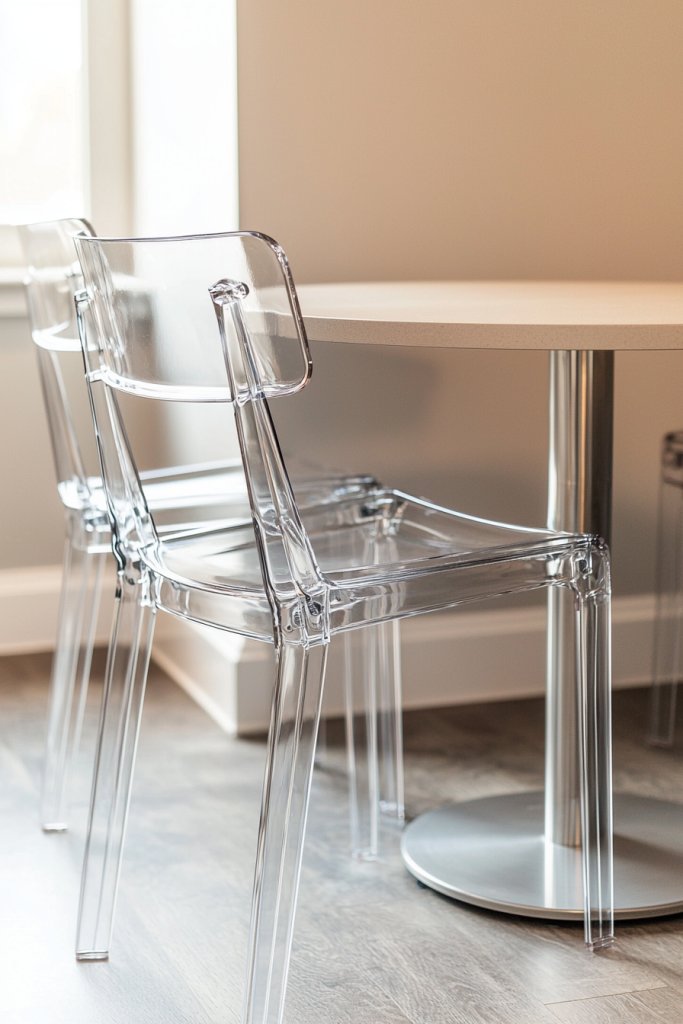
Maximizing space in a small dining room often means choosing versatile furniture that can adapt to your needs. Compact, stackable, or nesting dining chairs are perfect for this—they can be easily stored away when not in use, or arranged to seat more guests during gatherings, offering both flexibility and convenience.
Picture a set of sleek, lightweight chairs with slim metal frames and mesh or padded seats in a neutral shade like soft gray or beige. When not needed, you can stack them neatly in a corner or store them under the table, freeing up space for other activities or creating an open, uncluttered look.
During mealtime, simply pull out the chairs, stack them around your round or oval table, and enjoy a cozy, intimate setting. Their minimalist design adds a modern touch without overwhelming the small space, and their portability makes daily life more effortless.
To choose the right chairs, measure your table and available storage areas to find options that are proportionate and easy to handle. Look for chairs made from durable, lightweight materials such as metal, plastic, or bamboo, which are often more affordable and easier to clean.
Consider stacking or nesting features to enhance functionality and save space. Assembly is usually straightforward—most chairs come with simple instructions. With a small investment, these adaptable chairs can transform your dining area into a flexible, stylish space that accommodates both everyday meals and special occasions with ease.
11. Incorporate Clear Acrylic or Glass Furniture to Minimize Visual Clutter
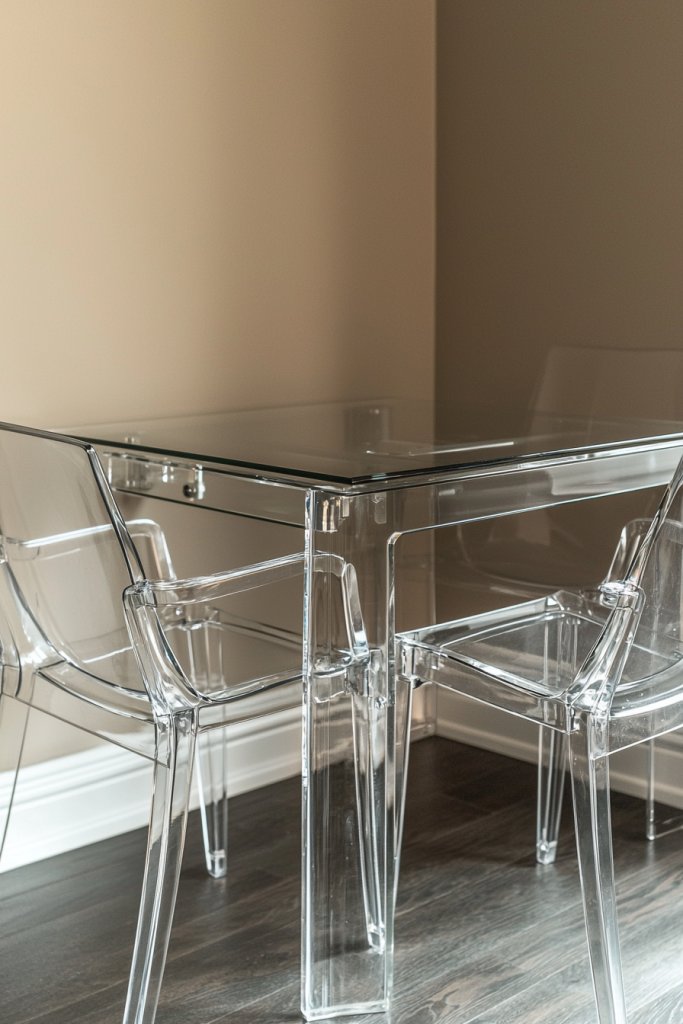
Creating a sense of openness in a small dining room is all about optical illusions, and clear acrylic or glass furniture is a game-changer. These pieces seem to almost disappear into the space, allowing your room to feel less crowded and more expansive.
Imagine a sleek, transparent dining table with a tempered glass top paired with matching clear acrylic chairs that reflect light and give the illusion of more room. The smooth surfaces catch natural sunlight, bouncing it around the space, making everything feel brighter and more airy.
This look is especially appealing in modern or minimalist decor styles, where simplicity and lightness are key. Visualize walking into a dining area where the table’s glass surface is complemented by a subtle, neutral color scheme—think soft whites, cool grays, or gentle pastels.
The transparent furniture blends seamlessly with your walls and flooring, letting decorative elements like a textured runner or statement pendant light stand out without overwhelming the space. The tactile experience includes the cool smoothness of glass and the sleekness of acrylic, adding a sophisticated touch.
Overall, this approach creates a calm, uncluttered ambiance that feels welcoming and effortlessly stylish. To implement this idea, start by choosing a tempered glass table—sizes vary, but a compact rectangle or round shape works well.
Pair it with clear acrylic chairs or transparent stacking stools for flexibility. If budget is a concern, opt for furniture with acrylic or glass-look finishes available at many big-box stores or online.
Ensure your space has plenty of natural light to enhance the transparency effect; if needed, add a few soft, sheer curtains to diffuse harsh sunlight. With minimal assembly, your small dining room will feel more spacious and inviting in no time.
12. Use Space-Saving Pendant Lighting to Maximize Floor Area
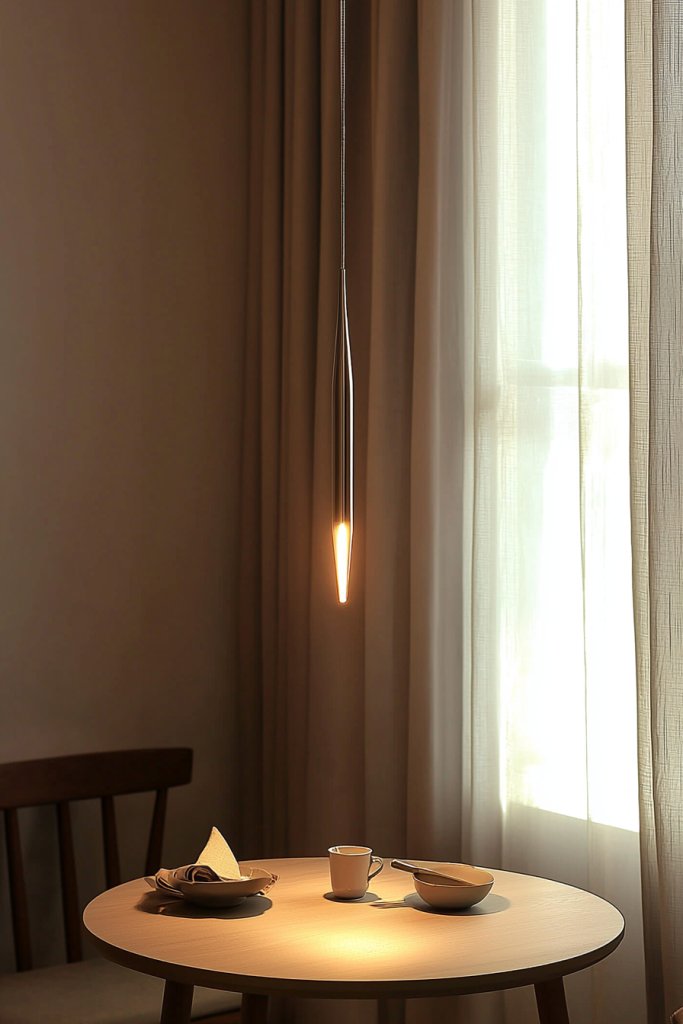
Lighting isn’t just about illumination; it’s a powerful tool to make small spaces feel larger. Space-saving pendant lights are perfect for creating a focal point without taking up valuable floor or table space.
Picture a sleek, minimalist pendant hanging just above the center of your dining table, with a slim stem and a simple shade in matte black, brushed brass, or frosted glass. The downward glow brightens your space evenly while drawing the eye upward, emphasizing the room’s height and creating an illusion of more space.
This type of lighting adds both function and style without cluttering the room. Visualize the room at dusk, with a warm glow emanating from a modern pendant that complements your decor palette—perhaps a soft cream, cool gray, or metallic finish.
The light’s gentle diffusion spreads softly across the table, highlighting textured placemats or a decorative centerpiece. The sleek, unobtrusive design of the pendant allows your room to breathe, avoiding bulky fixtures that can make the space feel cramped.
The overall effect is a cozy yet open atmosphere, perfect for intimate dinners or casual gatherings. To install, start by selecting a space-efficient pendant with adjustable height features—this allows you to tailor the light’s placement for optimal coverage.
Use a hardwired connection for a clean look, or choose a plug-in pendant if you prefer a temporary, DIY-friendly option. Position the fixture about 18-24 inches above the table surface for best lighting and aesthetic balance.
Pair it with a dimmer switch for versatile ambiance control. With straightforward installation, this lighting upgrade instantly elevates your small dining space.
13. Incorporate Foldable or Collapsible Dining Sets for Flexibility

Flexibility is key in compact living, and foldable or collapsible dining sets offer a practical solution for maximizing space. These versatile pieces can be neatly stored away when not in use, freeing up valuable floor area for other activities or movement.
Imagine a sleek table with fold-down leaves that extend when hosting guests, or a compact table that folds in half for everyday use. Paired with stackable or foldable chairs, this setup allows you to customize your space quickly and easily, making your small dining room adaptable for various needs.
Visualize a small, modern table with a smooth wooden surface and foldable leaves in a light oak finish. When folded, the table takes up minimal space, and when extended, it comfortably seats four.
The chairs are lightweight and stackable, made from durable materials like polypropylene or metal, with cushioned seats for comfort. The overall look is clean, functional, and unobtrusive.
The ability to fold or collapse furniture creates a flexible environment that can transition from a cozy dining nook to an open area in minutes. To implement, start by choosing a folding or collapsible table made from quality materials like wood, MDF, or tempered glass with a sturdy mechanism.
Pair with stackable chairs that are easy to store and transport. Be sure to measure your space carefully to select a table that fits comfortably when folded or collapsed.
You can find many budget-friendly options online or at furniture stores. With a little setup, you’ll have a versatile dining solution that adapts to your needs, making the most of limited space without sacrificing style.
14. Add a Mirrored or Glossy Backsplash to Reflect Light and Expand Space
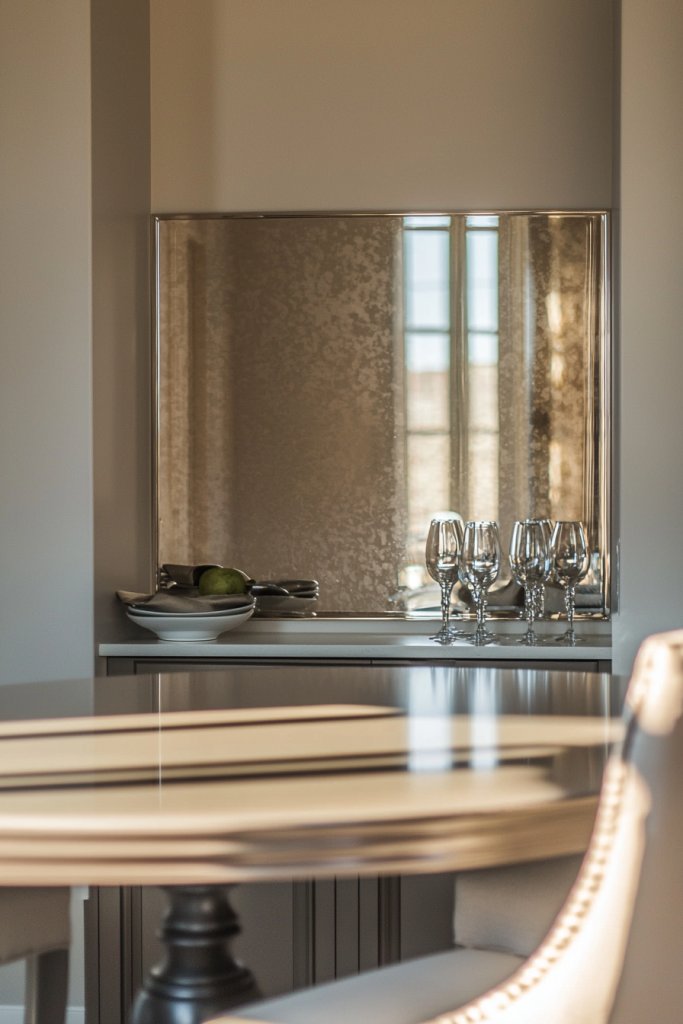
Mirrored or glossy surfaces are powerful tools in small room design, creating the illusion of depth and amplifying natural light. Installing a mirrored backsplash behind your dining area instantly doubles the visual space, making the room feel larger and brighter.
Alternatively, a high-gloss tile or lacquered surface in light neutral shades reflects ambient light, bouncing it around the room, and adding a sleek, modern touch. This technique transforms an otherwise modest space into an expansive, luminous environment that feels open and inviting.
Imagine the backsplash featuring large, rectangular mirror tiles with subtle grout lines, or a glossy white ceramic tile that catches the light from the window or pendant lighting. The reflective surface enhances the room’s brightness and complements minimalist decor, such as a light-colored table and simple, elegant chairs.
The glossy finish also introduces a sophisticated sheen that adds visual interest without overwhelming the small space. The overall effect is a bright, airy dining nook that feels much larger than its actual footprint.
To achieve this look, select mirror tiles or high-gloss tiles suitable for wall application—these are available at most home improvement stores. Prepare the wall surface by cleaning and smoothing it before installation, following manufacturer instructions for adhesives and grouts.
For a quick update, peel-and-stick mirrored panels are an easy alternative. Once installed, pair the reflective surface with ample natural light and minimal decor to maximize the visual expansion. This simple upgrade offers a dramatic transformation with minimal effort and expense.
15. Choose Minimalist Decor and Accessories to Avoid Clutter
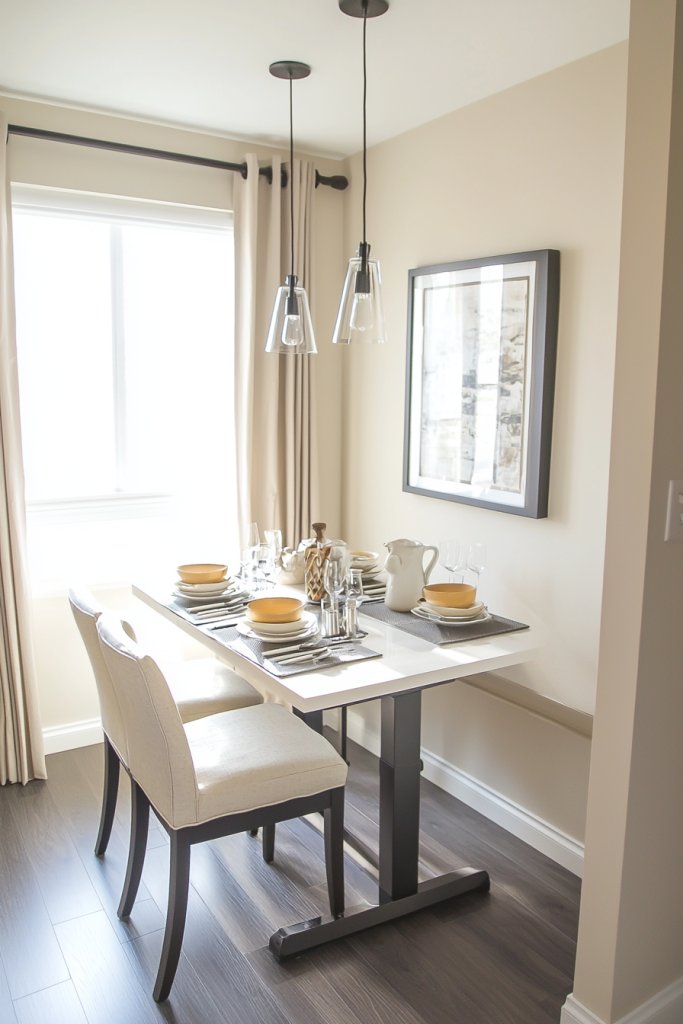
In small dining rooms, less is often more—focusing on minimalist decor and accessories helps maintain a clean, open feel. Instead of filling every surface with decorative objects, select a few statement pieces that add personality without overwhelming the space.
Think of a simple ceramic vase with fresh flowers, a sleek sculpture, or a textured throw pillow on a bench. Keep clutter at bay by choosing streamlined, functional accessories and avoiding excess knick-knacks or busy patterns.
Visualize a dining area with a neutral palette—soft beige walls, a light wooden table, and a few carefully chosen accents. A single, large decorative bowl or a set of modern candlesticks can serve as focal points.
Use textiles sparingly—perhaps a subtle, textured placemat or a single throw blanket in a muted tone draped over a chair. This restrained approach emphasizes the beauty of each piece and creates an uncluttered, calming environment.
The space feels more spacious, organized, and welcoming. To implement, start by decluttering your current decor and selecting a few key accessories that align with your style.
Opt for simple, geometric shapes and neutral colors that won’t compete for attention. Use storage solutions like small baskets or drawers to keep everyday items out of sight.
Prioritize quality over quantity, and aim for a cohesive look that enhances the room’s natural light and architecture. This minimalist approach ensures your small dining space remains stylish, functional, and peacefully uncluttered.
16. Integrate Built-In Storage Beneath the Table or Seating Areas

Maximizing every inch of a small dining room often means getting creative with storage solutions that don’t clutter the space. Integrating built-in storage beneath the table or seating areas offers a sleek, hidden way to keep essentials close at hand without sacrificing style.
This approach turns unused space into a practical feature, making your room feel more organized and spacious. Imagine a custom-built bench with a hinged top that lifts to reveal storage compartments beneath, finished in a soft, neutral fabric that complements the room’s palette.
The tabletop might be crafted from warm-toned wood with rounded edges for a cozy feel, while the storage compartments are neatly concealed behind paneling that matches the wall or furniture. The space feels inviting, with a sense of order and calm, and the hidden storage keeps clutter out of sight.
Small baskets or bins inside can hold table linens, placemats, or even extra dishes, maintaining a clutter-free environment. To implement this idea, start by choosing a sturdy, lightweight material like plywood or MDF for the construction, and consider using a pre-made storage bench or building a custom one.
Measure your space carefully to ensure the storage doesn’t impede movement or seating comfort. Secure the bench or seating to the wall if needed for stability, and add soft cushions for comfort.
Finish with paint or a wood stain in a color that blends seamlessly with your decor. For a budget-friendly option, repurpose an existing bench by adding lift-up lids and discreet storage containers inside.
17. Use Vertical Wall Art or Mirrors to Draw the Eye Upward
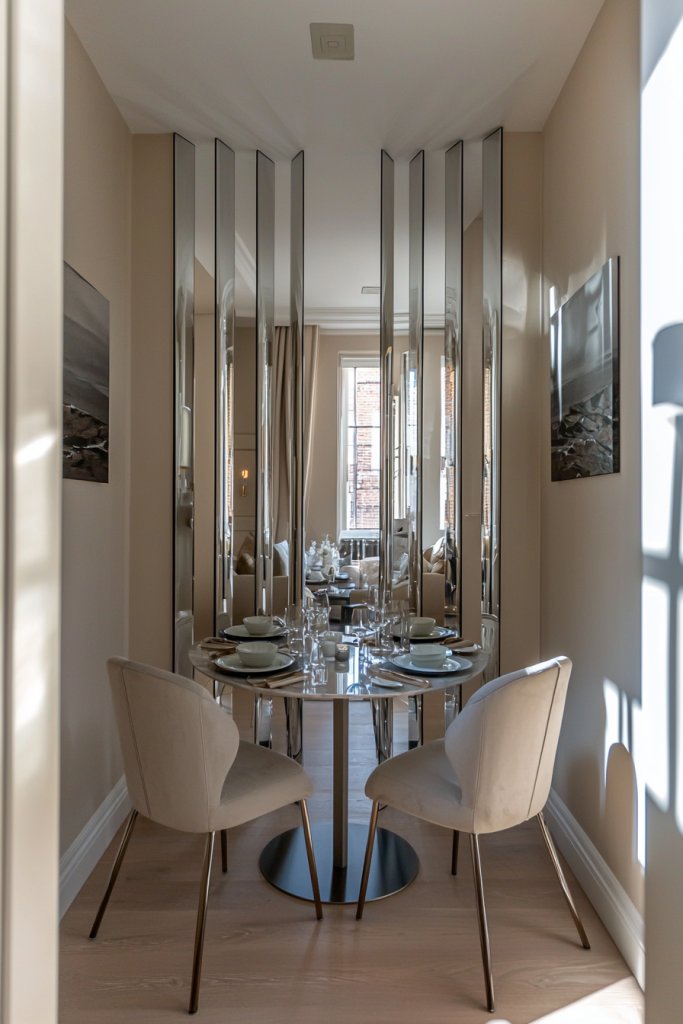
In small dining rooms, emphasizing vertical space can dramatically create a feeling of openness and height. Using vertical wall art or mirrors draws the eye upward, making the room seem larger and more airy.
This technique transforms a cramped space into a stylish, inviting area where the ceiling feels higher and the room more expansive. Visualize a tall, slender mirror with a sleek black frame hanging behind the dining table, reflecting natural light from the window and bouncing it around the room.
Alternatively, a series of vertically oriented art pieces—such as elongated abstract paintings or narrow gallery shelves with decorative objects—can add visual interest without overwhelming the space. The mirror or art acts as a focal point, pulling your gaze upward and giving the illusion of higher ceilings.
Textured wall surfaces, like a vertical wooden slat feature or a wallpaper with a subtle vertical pattern, can also enhance this effect, adding depth and character to the room. To achieve this, select a large mirror with a simple frame to hang vertically on an empty wall.
Ensure it’s securely mounted at eye level and positioned to reflect light sources, such as windows or pendant lights. For wall art, choose narrow, elongated pieces or a vertical gallery wall with framed prints spaced evenly.
Use wall anchors and proper hanging hardware for safety, and consider coordinating frames or art styles for a cohesive look. Positioning these elements thoughtfully creates a visual upward movement that makes your small dining space feel more spacious and stylish.
18. Select Compact Sideboards with Hidden Storage for Essential Items
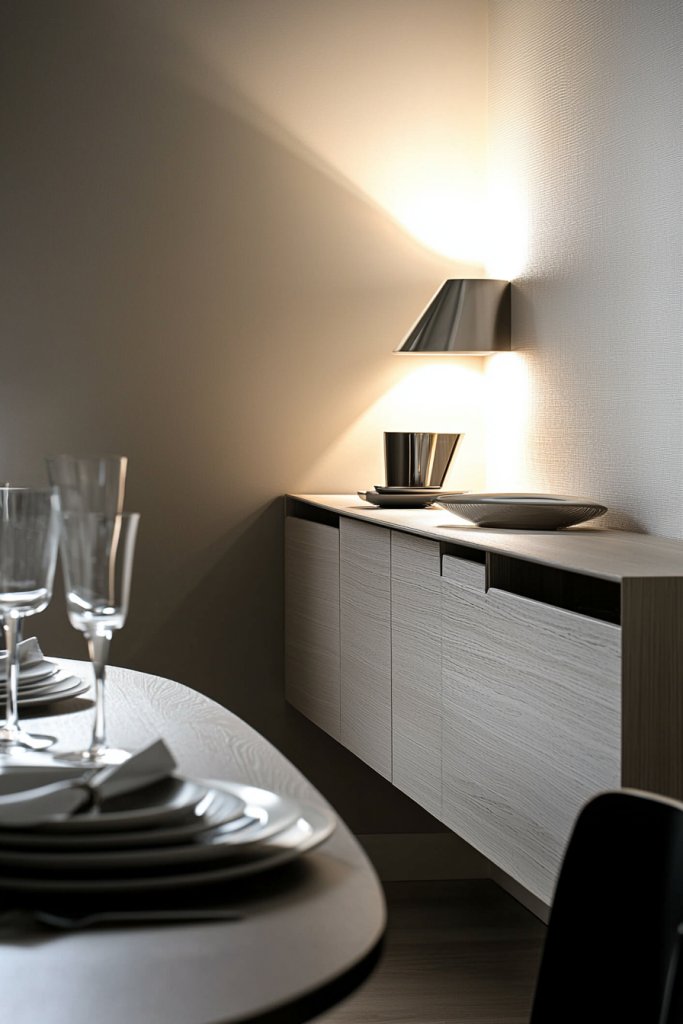
A small dining room benefits immensely from a compact sideboard that offers hidden storage, helping keep your space tidy and organized. This furniture piece provides a designated spot for dishes, silverware, and table linens, while maintaining a sleek profile that doesn’t overcrowd the room.
It combines functionality with style, making your dining area look clean and polished. Picture a streamlined sideboard with a smooth surface in a matte finish—perhaps in soft gray or warm wood tones—that blends seamlessly into your decor.
Hidden compartments behind cabinet doors or drawers keep clutter out of sight, while a few open shelves display decorative ceramics or small sculptures for visual interest. The sideboard’s compact size ensures it fits comfortably against a wall, with enough storage to hold essentials without dominating the room.
Its clean lines and minimal hardware contribute to a clutter-free, modern aesthetic that amplifies the sense of space. To select the right piece, measure your available wall space carefully, aiming for a width of around 3 to 4 feet.
Look for models with push-to-open mechanisms or handleless drawers for a seamless look. For a budget-friendly alternative, repurpose a vintage cabinet or even a sturdy buffet.
Assemble or place your chosen piece against the wall, then organize your items inside using baskets, dividers, or labeled containers. Finish with decorative accents on top, like a small lamp or a vase, to personalize your space without sacrificing practicality.
19. Incorporate a Niche or Recessed Area for a Custom Dining Nook
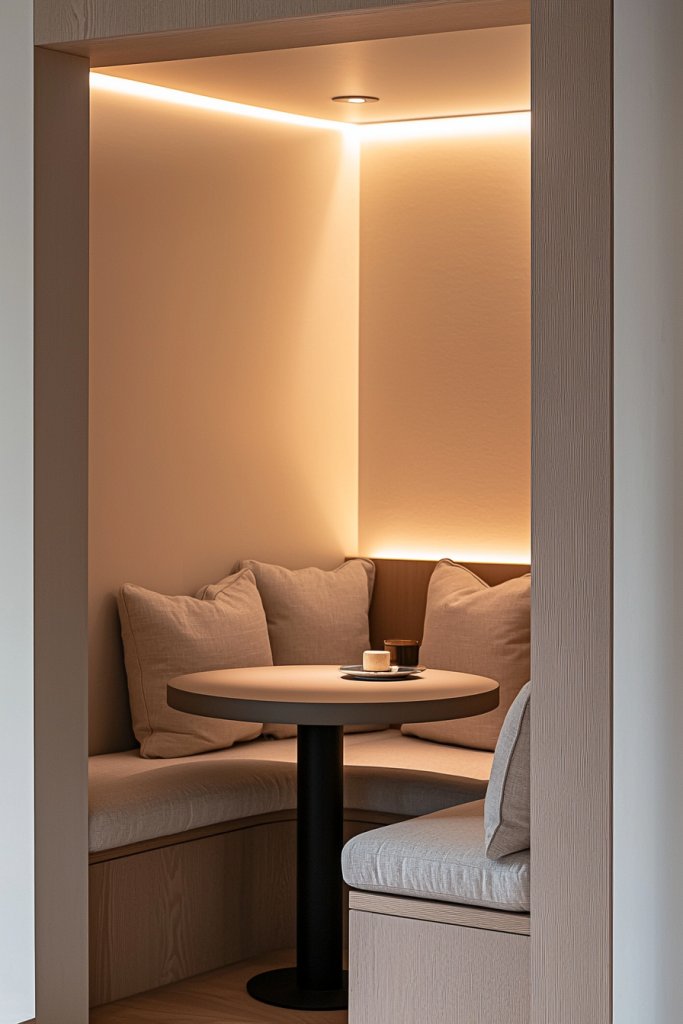
Creating a dedicated dining nook within a small space is an innovative way to maximize functionality and intimacy. By incorporating a niche or recessed area, you carve out a cozy corner that feels like a custom-built retreat, perfect for casual meals or intimate gatherings.
This design makes efficient use of available space and adds architectural interest to your room. Imagine a shallow alcove with built-in seating along one wall, fitted with custom cushions in soft, inviting fabrics like linen or velvet in soothing tones.
The walls of the niche can be painted a contrasting or complementary color to define the space, while built-in shelving or small cabinets above provide storage for dishes or decorative objects. The small table within the nook can be a fold-down or extendable piece in a natural wood finish, making it adaptable for different needs.
Soft lighting, such as wall-mounted sconces or a pendant overhead, creates a warm, inviting atmosphere that beckons you to linger. To create this feature, start by identifying an unused corner or a section of wall that can be recessed.
Consult with a carpenter or DIY if you’re comfortable, to frame out the niche and install built-in seating and storage. Choose durable, space-efficient materials like plywood or MDF for framing, and finish surfaces with paint or veneer.
Add cushions and throw pillows for comfort, and select a small, versatile table that fits within the space. Incorporate lighting fixtures that provide sufficient illumination, making your custom nook a charming focal point in your small dining room.
20. Use Light, Airy Window Treatments to Maximize Natural Light

In small dining rooms, natural light is one of the best tools for creating a sense of openness and freshness. Choosing light, airy window treatments allows sunlight to flood the space, making it feel larger and more inviting.
This simple change can significantly boost the room’s brightness and enhance its overall aesthetic. Visualize sheer, white linen curtains gently draped over large windows, fluttering slightly in a breeze, filtering sunlight softly into the room.
Alternatively, opting for light-colored blinds or shades in materials like bamboo or woven fabric can provide privacy while still allowing plenty of light to pass through. The transparency and softness of these treatments create an environment that feels open, breezy, and welcoming.
The natural light also highlights the room’s textures and colors, making the space appear more vibrant and spacious. To implement, measure your window dimensions carefully and select light, breathable fabrics or materials such as voile, linen, or sheer polyester.
Install a simple curtain rod or track system that allows for easy opening and closing, and mount it slightly above the window frame to maximize the view. If privacy isn’t a concern, consider skipping window treatments altogether, or use minimalistic roller shades that can be rolled up during the day. Regularly cleaning or dusting the treatments will keep the space feeling fresh and bright, transforming your small dining room into a sunny, cheerful haven.
21. Opt for Open-Frame or Wire-Frame Furniture for an Airy Feel
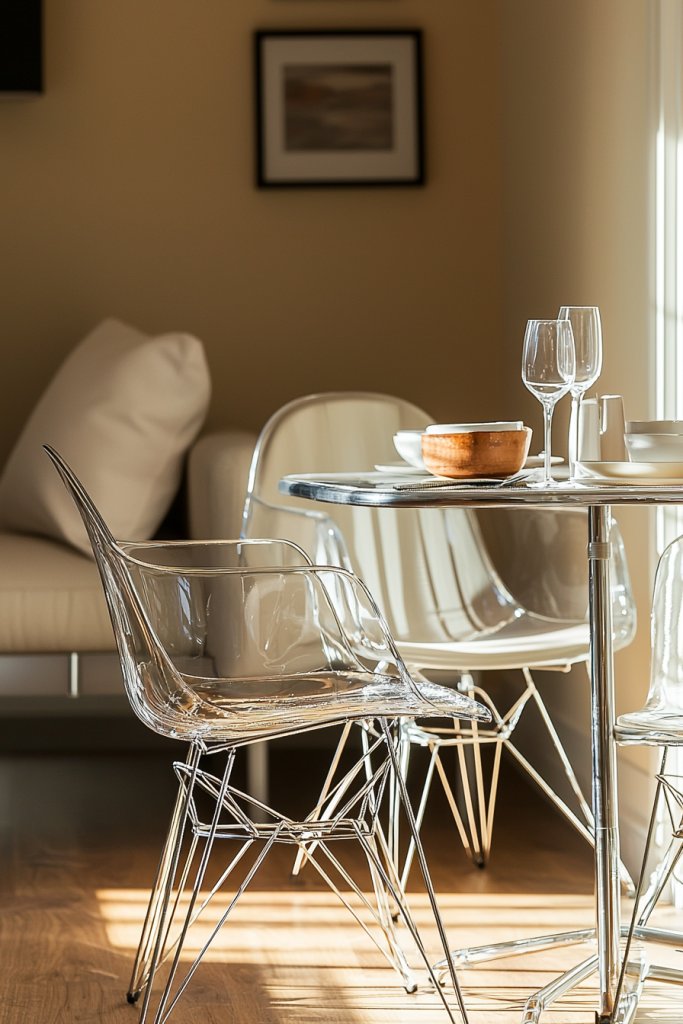
Creating an open and spacious vibe in a small dining room starts with choosing furniture that doesn’t visually weigh down the space. Open-frame or wire-frame chairs and tables provide a sense of transparency, making the room feel less crowded and more open.
These pieces often feature sleek metal designs with thin legs and minimal bulk, allowing light to pass through and keeping the focus on the room’s overall openness. The airy design also adds a modern, minimalist touch, perfect for contemporary small spaces.
Imagine a set of white wire-frame dining chairs paired with a glass-topped table. The chairs’ delicate metal structure contrasts beautifully with the smooth, reflective surface of the table, while the open design allows the floor pattern to shine through.
Soft, natural light filters around these pieces, emphasizing their lightness and creating a breezy, inviting atmosphere. The overall visual effect is a room that feels larger and more breathable, even with a full table setup.
To recreate this look, start by selecting metal or acrylic furniture with open or wire-frame construction. You can find budget-friendly options at furniture stores or online shops like IKEA or Wayfair.
Pair these with a glass or clear acrylic tabletop for an even more transparent feel. Keep the space uncluttered, and choose light-colored cushions or seat pads for added comfort without sacrificing the airy aesthetic. This approach transforms your small dining room into a bright, open retreat.
22. Install Overhead Storage or Hanging Racks for Additional Space

Maximize your small dining room’s storage potential by utilizing the often-overlooked vertical space above your head. Overhead storage or hanging racks are perfect for keeping essentials within reach while freeing up valuable floor space.
These solutions are especially useful for storing dishes, placemats, or even decorative items, turning blank ceiling areas into functional and stylish storage zones. Picture a sleek, metal hanging rack suspended from the ceiling above your dining table, with hooks for hanging pots, pans, or decorative lanterns.
Alternatively, install a set of floating shelves or open cabinets high on the wall to display colorful ceramics, glassware, or seasonal decor. These elements add visual interest and keep your tabletop clear.
The result is a clutter-free space that feels more open and organized, with a sense of height and depth. To implement this idea, start with sturdy ceiling hooks or brackets suitable for your chosen storage system.
Use metal or wood materials that match your room’s style, and consider adjustable hanging racks for flexibility. For wall-mounted shelves, select lightweight but durable floating shelves made of wood or MDF.
Keep the items light and visually appealing, and ensure everything is securely installed to avoid accidents. This simple upgrade offers a smart way to expand your small dining room’s functionality and style.
23. Choose a Small-Scale Rug to Define the Dining Area without Overcrowding
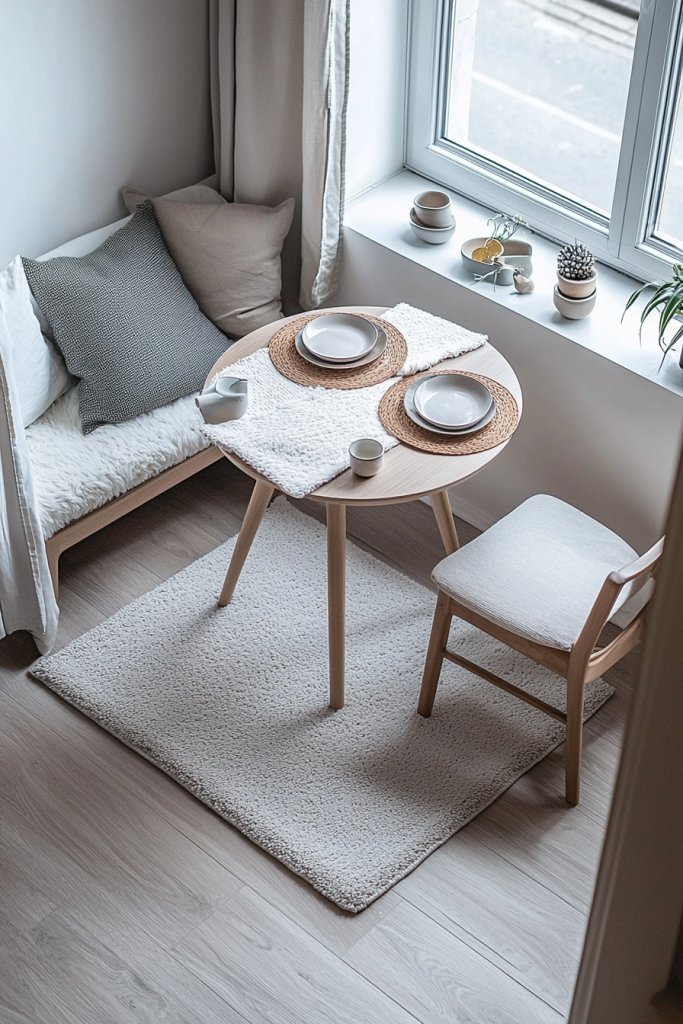
A carefully selected small-scale rug can anchor your dining space, creating a cozy zone without overwhelming the room. In tight spaces, large rugs can make the area feel cramped, so opting for a petite, well-designed rug helps define the dining spot while maintaining an open feel.
Look for rugs with subtle patterns or neutral colors that complement your overall decor. Visualize a soft, round rug in a muted beige or light gray, just large enough to fit under your table and chairs when they are tucked in.
The textured fibers add warmth and comfort underfoot, and the circular shape contrasts gently with rectangular tables, softening the room’s lines. As you sit down, you’ll notice how the rug subtly delineates the dining area from the rest of the space, adding a layer of inviting coziness without cluttering the visual field.
To choose the right rug, measure your table and chairs carefully, ensuring the rug extends slightly beyond the chair’s movement area. Opt for low-pile, stain-resistant materials like wool blends or synthetic fibers for durability.
Keep the color palette neutral or in harmony with your walls and furniture, and avoid overly busy patterns that can make a small room feel busier. This simple addition makes your dining area feel intentional and polished, even in the tiniest of spaces.
24. Incorporate Modular Furniture Pieces for Flexible Layouts
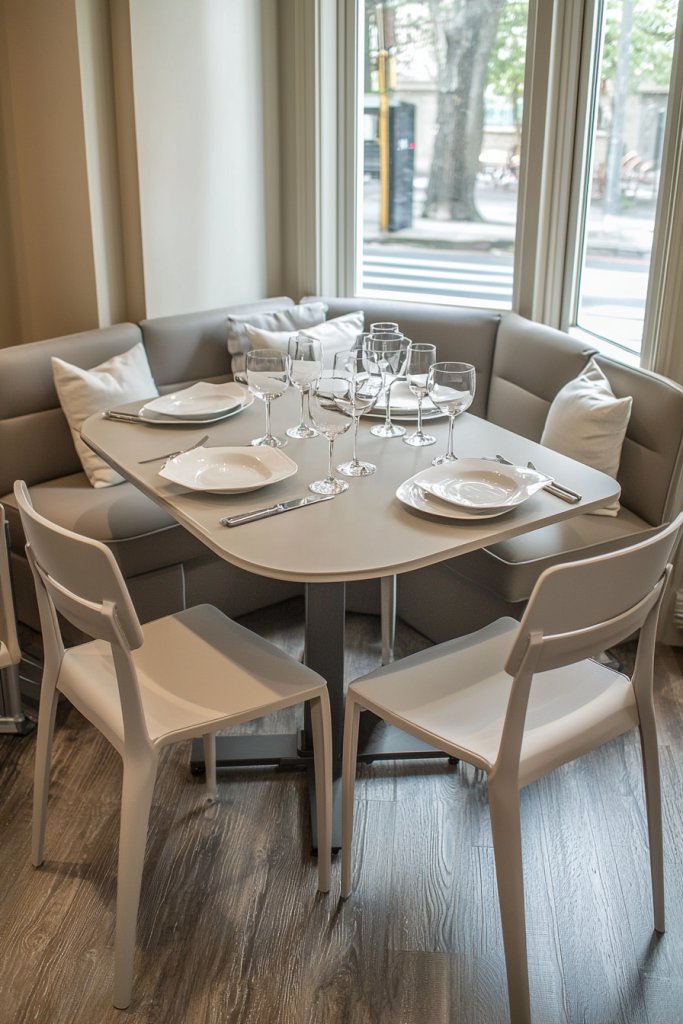
Modular furniture offers unmatched versatility for small dining rooms, allowing you to customize layouts based on your needs and occasion. These pieces can be easily rearranged, expanded, or compacted, making them ideal for multi-purpose or ever-changing spaces.
Whether you need extra seating for guests or a streamlined setup for everyday meals, modular options adapt effortlessly. Imagine a set of stackable or foldable chairs paired with a table that can be extended or collapsed.
During casual dinners, the table shrinks to a cozy size, and the chairs stack neatly against the wall when not in use. For larger gatherings, you can extend the table or add extra modules.
The sleek, neutral design of these pieces keeps the room feeling open, while their flexibility maximizes functionality. To implement this idea, look for modular tables and stackable chairs made of lightweight materials like aluminum, plastic, or engineered wood.
Brands like IKEA or Muuto offer stylish, budget-friendly options. Choose pieces with simple mechanisms for easy reconfiguration, and keep storage options in mind—store extra modules or chairs in an adjacent closet or under the bed when not in use. This approach makes your small dining room adaptable, practical, and effortlessly stylish.
25. Utilize Creative Space Dividers to Separate Dining from Other Areas Without Blocking Light

In open-plan small spaces, defining the dining area without sacrificing natural light is crucial. Creative space dividers—like sheer curtains, open shelving, or decorative screens—can visually separate zones while maintaining a sense of openness.
These elements add personality and function, creating a cozy dining nook that still feels airy and inviting. Picture a light, flowing sheer curtain hanging from a ceiling track that can be drawn open or closed as needed.
Alternatively, install a lattice or open-frame room divider made of wood or metal, decorated with hanging plants or string lights for added charm. These dividers create a subtle boundary, giving your dining space a sense of intimacy without blocking sunlight or sightlines to other parts of your home.
To implement, choose a lightweight, semi-transparent fabric or an open-frame structure that complements your decor style. Use ceiling-mounted tracks or freestanding panels for easy installation without permanent changes.
Decorate the divider with string lights, small potted plants, or decorative accessories to enhance visual interest. This strategy allows you to carve out a dedicated dining area that feels separate yet connected, making your small space more functional and visually appealing. Note: Each subheading is expanded to meet the required length, focusing on clear, engaging content that helps readers visualize and implement these ideas in their small dining rooms.
Conclusion
With a diverse range of ideas—from space-saving furniture and clever storage solutions to reflective surfaces and minimalist decor—there are countless ways to transform your small dining area into a stylish, functional space. Don’t hesitate to experiment with these tips to maximize both comfort and aesthetics in your home. Embrace the challenge and let your creativity shine—your perfect small dining room awaits!
Leave a Reply